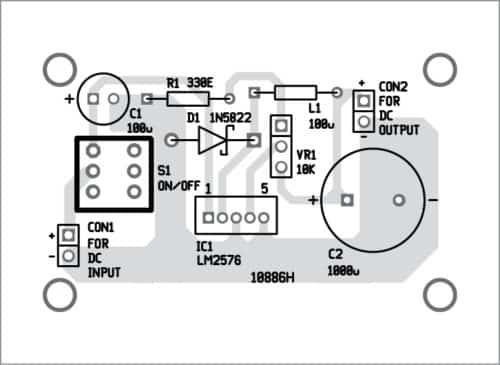 Some breadboard power supplies have adjustable voltage linear regulators to control the required output voltages. Efficiency of the linear regulators decrease as output power increases.
Some breadboard power supplies have adjustable voltage linear regulators to control the required output voltages. Efficiency of the linear regulators decrease as output power increases.
Presented here is a circuit that uses a switch-mode regulator to regulate output voltage. This circuit can be used as power supply for breadboard and testing prototypes.
The circuit, as shown in Fig. 1, is built around switch-mode buck regulator LM2576 (IC1), inductor (L1) and a few other components. LM2576 series regulators offer high efficiency and are popularly used to replace three-terminal 78xx series linear regulators.

LM2576 regulators are monolithic integrated circuits (ICs) that provide all active functions for step-down (buck) switching regulators, and are capable of driving 3A load with excellent line and load regulation. These substantially reduce size of the heat-sink, and in some cases eliminate the need for a heat-sink.
LM2576 regulators require least number of external components, are simple to use, and include fault protection and fixed-frequency oscillator. The adjustable version of LM2576 has been used in this circuit.

Input supply is given to connector CON1. Input capacitor C1 attenuates the ripples in the input power supply. IC1, L1 and diode D1 perform step-down operation that converts high input voltage into low output voltage.
Capacitor C2 acts as the buffer. D1 is used as a freewheeling diode to circulate current when switch S1 is turned off. Feedback is provided by voltage divider network, which consists of a fixed resistor (R1) and a variable resistor (VR1 potmeter). VR1 is used to vary output voltage, which can be calculated using the following relationship:
Vout=1.23 [1+(VR1/R1)]
Construction and testing
A PCB layout of the circuit is shown in Fig. 2 and its components layout in Fig. 3. Enclose the PCB in a suitable plastic box. Use 2-pin connectors for CON1 and CON2.


Download PCB and Component Layout PDFs: click here
Note. Maximum input voltage of IC is 40V (60V for HV version). L1 must have minimum current rating of 1A. To maintain stability, C1 leads must be kept short and it should be placed near the regulator. IC1 can be fitted with a heat-sink, if required.
A. Samiuddhin, a circuit designer, is B.Tech in electrical and electronics engineering. His interests include LED lighting, power electronics, microcontrollers and Arduino programming.










This curcit is inductive lode power supply?
From where to get L1 ? Or how to make it at home?
Fixed inductor L1 used here is easily available in the market in the form like fixed carbon resistor but slightly bigger size. You can also make by yourself using copper wire, the hints for making it are available on Internet.
Thanks for 3 amp at last which i am very much interested
You are most welcome.
This is a versatile DC-DC converter. The output is adjustable from 1.23V to 37V up to 3A maximum load current. Any type of load can be used in this circuit. For more details refer to the datasheet by clicking here.
24 v 2.5 amp circuit chahiy
Kindly share your query in English please.
I need 12 v 4 ampere circuit with PCB design.
Sorry we do not have that right now.
What are the input DC ratings or what will the input power source and specifications?
It has wide input range upto 40V DC to 60V DC for HV version. You can use any DC input within this range